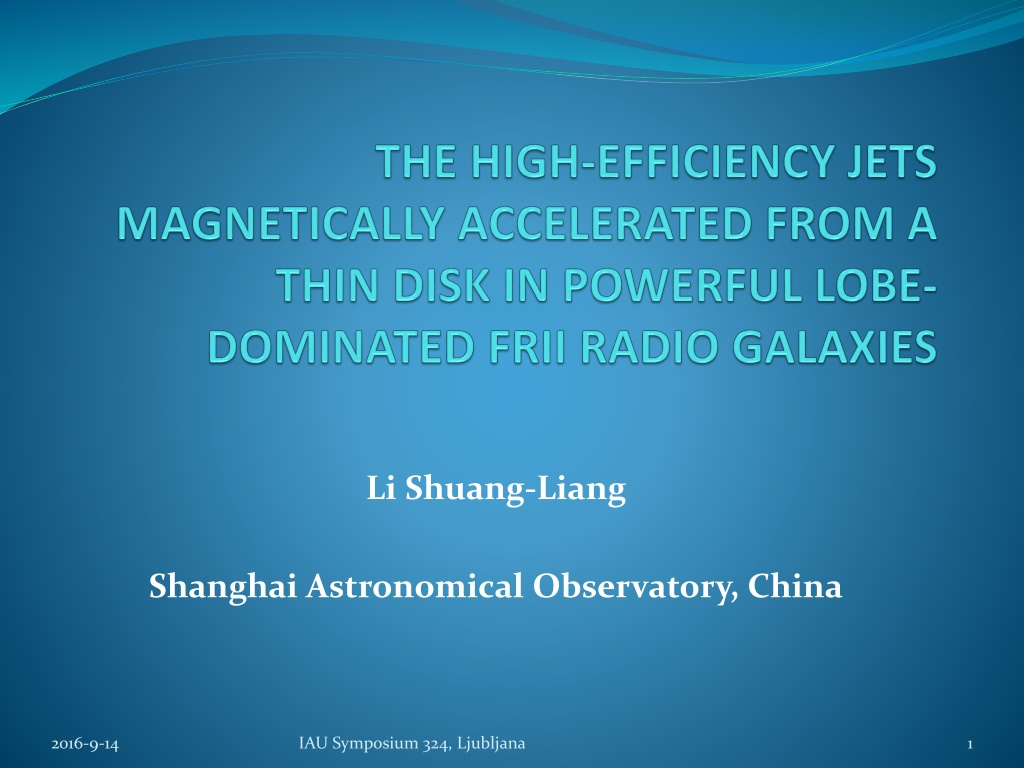
Understanding Accretion Disk Models in Astrophysics
Explore the intriguing world of accretion disk models in astrophysics, focusing on jet efficiency, radiative processes, and disk properties affected by jets. Discover how observational data and theoretical simulations shed light on the dynamics of accretion disks around black holes.
Download Presentation

Please find below an Image/Link to download the presentation.
The content on the website is provided AS IS for your information and personal use only. It may not be sold, licensed, or shared on other websites without obtaining consent from the author. If you encounter any issues during the download, it is possible that the publisher has removed the file from their server.
You are allowed to download the files provided on this website for personal or commercial use, subject to the condition that they are used lawfully. All files are the property of their respective owners.
The content on the website is provided AS IS for your information and personal use only. It may not be sold, licensed, or shared on other websites without obtaining consent from the author.
E N D
Presentation Transcript
Li Shuang-Liang Shanghai Astronomical Observatory, China 2016-9-14 IAU Symposium 324, Ljubljana 1
Outline 1 MOTIVATION 2 MODEL 3 RESULTS 4 CONCLUSIONS AND DISCUSSION 2016-9-14 IAU Symposium 324, Ljubljana 2
1 MOTIVATION FRI (3C 449) FRI: bright jets in the centre and edge-darkened radio lobes. FRII: edge-brightened radio lobes and hot spots (Fanaroff & Riley 1974). FRII (Cyg A) 2016-9-14 IAU Symposium 324, Ljubljana 3
Accretion disk model Thin disk Ghisellini & Celotti (2001) ADAF 2016-9-14 IAU Symposium 324, Ljubljana 4
Several observational data discovered the jet efficiency (defined as R = Ljet/Lbol) of some luminous lobe dominated FRII could be very high. 2016-9-14 IAU Symposium 324, Ljubljana 5
R=Ljet/Lbol=25 Punsly 2011 1: The low-frequency (151 MHz) flux from the radio (e.g., Willott et al. 1999) 2: The cavities blown up by jets (e.g., Birzan et al. 2004) 3: The broadband spectra associated with the relativistic parsec scale jet (e.g., Ghisellini et al. 2010). 2016-9-14 IAU Symposium 324, Ljubljana 6
Lbol= th c2 R= Ljet/Lbol= Q/ th Ljet= Q c2 Where this the radiativeefficiency and Qis the jet production efficiency. For thin disk, th~0.1 Simulations found the maximal efficiency Q ~140% was achieved in the BZ process simulations for a = 0.99. (McKinney 2005; Tchekhovskoy et al. 2010, 2011) Rmax~14 2016-9-14 IAU Symposium 324, Ljubljana 7
Li & Cao (2012) and and Li & Begelman (2014) produced a model for an accretion disk with magnetically driven outflows/jets, in which the effects of jets are properly included. It was found that the disk properties can be significantly changed by the feedback of jets. The temperature of an thin disk with jets is obvious lower compared with that of a standard thin disk. This will directly result in the decrease of bolometric luminosity (and th) of the thin disk and the increase of jet efficiency R. 2016-9-14 IAU Symposium 324, Ljubljana 8
2 Model The equations of accretion disk The metric around the black hole reads (the geometrical unit G = c = 1 is adopted): 2016-9-14 IAU Symposium 324, Ljubljana 9
2016-9-14 IAU Symposium 324, Ljubljana 10
The mechanisms of jet formation BZ process BP process 2016-9-14 IAU Symposium 324, Ljubljana 11
3 Results p=(Pgas+Prad)/Pm 2016-9-14 IAU Symposium 324, Ljubljana 12
2016-9-14 IAU Symposium 324, Ljubljana 13
4 CONCLUSIONS AND DISCUSSION 1. According to our model, the reason for the high jet efficiency could be that most of released gravitational energy in the disk is carried away by jets, which results in the very low radiativeefficiency. 2. A theoretical maximum jet efficiency R ~ 1000 is found in this work, which is adequate even to take the episodic activity of jets into account. 3. Compared with the observational results, our study indicates that 10 < p< 20 is required for = 0.1 and B = 0.1Bp. 2016-9-14 IAU Symposium 324, Ljubljana 14
Lubow et al. (1994) Thin disk Thick disk Spurit & Uzdensky (2005), field bundles Cao & Spruit (2013), Li & Begelman (2014), large scale magnetic fields 2016-9-14 IAU Symposium 324, Ljubljana 15
Thanks! 2016-9-14 IAU Symposium 324, Ljubljana 16

